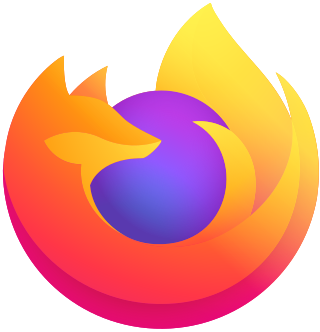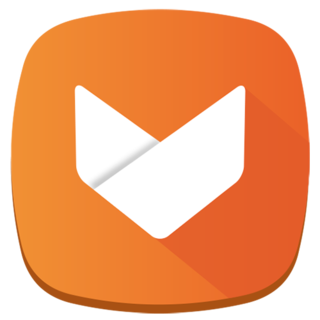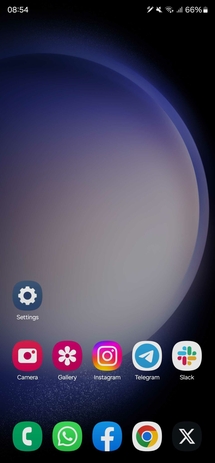
Firefox for Android is a web browser developed by Mozilla for Android smartphones and tablet computers. As with its desktop version, it uses the Gecko layout engine, and supports features such as synchronization with Firefox Sync, and add-ons.
The Android Package with the file extension apk is the file format used by the Android operating system, and a number of other Android-based operating systems for distribution and installation of mobile apps, mobile games and middleware. A file using this format can be built from source code written in either Java or Kotlin.
The version history of the Android mobile operating system began with the public release of its first beta on November 5, 2007. The first commercial version, Android 1.0, was released on September 23, 2008.
The operating system is developed by Google on a yearly cadence since at least 2011. New major releases are announced at Google I/O in May while still in beta testing with the stable version usually released to the public between August and October.

The Android Debug Bridge is a programming tool used for the debugging of Android-based devices. The daemon on the Android device connects with the server on the host PC over USB or TCP, which connects to the client that is used by the end-user over TCP. Made available as open-source software under the Apache License by Google since 2007, its features include a shell and the possibility to make backups. The adb software is available for Windows, Linux and macOS. It has been misused by botnets and other malware, for which mitigations were developed such as RSA authentication and device whitelisting.
This is a comparison of mobile operating systems. Only the latest versions are shown in the table below, even though older versions may still be marketed.

Aptoide is an online marketplace for mobile applications which runs on the Android and iOS operating systems. In Aptoide, unlike the Android-default Play Store and iOS-default App Store, there is not a unique and centralized store; instead, each user manages their own store. The software package is published by Aptoide S.A., a for-profit company incorporated in 2011, and headquartered in Lisbon, Portugal.

Wear OS is a version of Google's Android operating system designed for smartwatches and other wearables. By pairing with mobile phones running Android version 6.0 "Marshmallow" or newer, or iOS version 10.0 or newer with limited support from Google's pairing application, Wear OS integrates Google Assistant technology and mobile notifications into a smartwatch form factor. Wear OS is closed-source, in contrast to the free and open-source Android.

Material Design is a design language developed by Google in 2014. Expanding on the "cards" that debuted in Google Now, Material Design uses more grid-based layouts, responsive animations and transitions, padding, and depth effects such as lighting and shadows. Google announced Material Design on June 25, 2014, at the 2014 Google I/O conference.
Google TalkBack is an accessibility service for the Android operating system that helps blind and visually impaired users to interact with their devices. It uses spoken words, vibration and other audible feedback to allow the user to know what is happening on the screen allowing the user to better interact with their device. The service is pre-installed on many Android devices, and it became part of the Android Accessibility Suite in 2017. According to the Google Play Store, the Android Accessibility Suite has been downloaded over five billion times, including devices that have the suite preinstalled.

Puffin Browser is a remote browser developed by CloudMosa, an American mobile technology company founded by Shioupyn Shen.
Flutter is an open-source UI software development kit created by Google. It can be used to develop cross platform applications from a single codebase for the web, Fuchsia, Android, iOS, Linux, macOS, and Windows. First described in 2015, Flutter was released in May 2017. Flutter is used internally by Google in apps such as Google Pay and Google Earth as well as other software developers including ByteDance and Alibaba.

One UI is a user interface (UI) developed by Samsung Electronics for its Android devices running Android 9 "Pie" and later. Succeeding Samsung Experience, it is designed to make using larger smartphones easier and be more visually appealing. It was announced at Samsung Developer Conference in 2018, and was unveiled in Galaxy Unpacked in February 2019 alongside the Galaxy S10 series, Galaxy Buds and the Galaxy Fold.

Android 10 is the tenth major release and the 17th version of the Android mobile operating system. It was first released as a developer preview on March 13, 2019, and was released publicly on September 3, 2019.
HarmonyOS (HMOS) is a distributed operating system developed by Huawei for smartphones, tablets, smart TVs, smart watches, personal computers and other smart devices. It has a multi-kernel design with dual frameworks: the operating system selects suitable kernels from the abstraction layer in the case of devices that use diverse resources.

Google Messages is a text messaging software application developed by Google for its Android and Wear OS mobile operating systems, while it's also available via the Web.

Huawei Mobile Services (HMS) is a collection of proprietary services and high level application programming interfaces (APIs) developed by Huawei Technologies Co., Ltd. Its hub known as HMS Core serves as a toolkit for app development on Huawei devices. HMS is typically installed on Huawei devices on top of running HarmonyOS operating system, and on its earlier devices running the Android operating system with EMUI including devices already distributed with Google Mobile Services. Alongside, HMS Core Wear Engine for Android phones with lightweight based LiteOS wearable middleware app framework integration connectivity like notifications, status etc.

Live Transcribe is a smartphone application to get realtime captions developed by Google for the Android operating system. Development on the application began in partnership with Gallaudet University. It was publicly released as a free beta for Android 5.0+ on the Google Play Store on February 4, 2019. As of early 2023 it had been downloaded over 500 million times. The app can be installed from an .apk file by sideloading and it will launch, but the actual transcription functionality is disabled, requiring creation of an account with Google.







